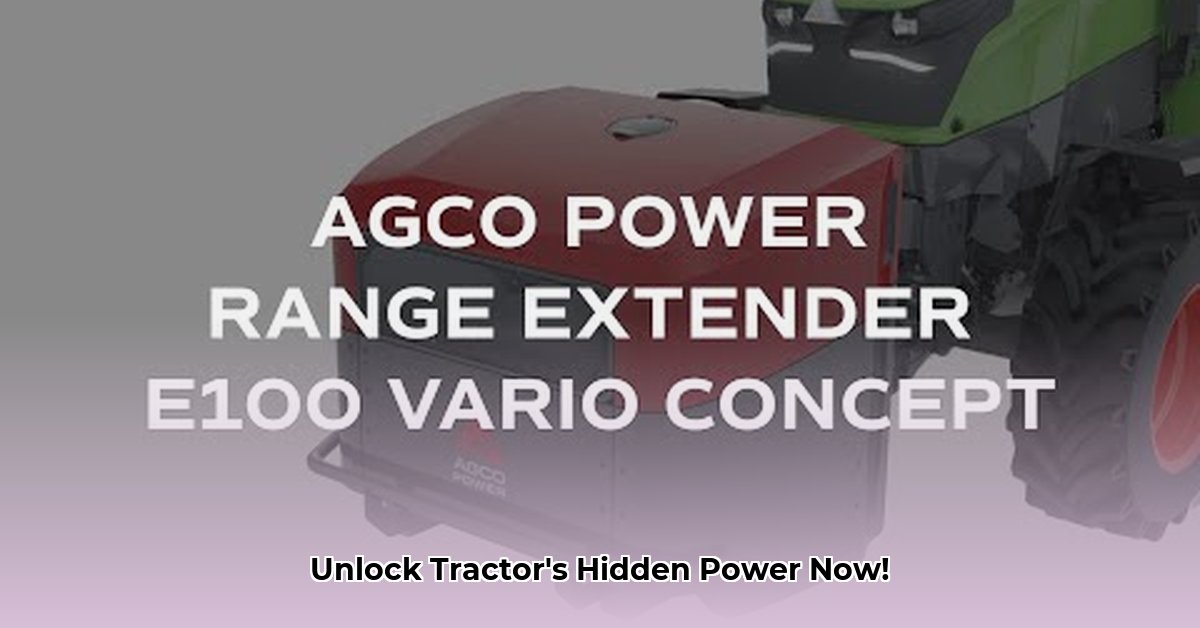
Tractor Range Extenders: A Comprehensive Guide for Farmers
Running out of fuel in the middle of a field is a costly and frustrating experience. A tractor range extender offers a solution by significantly increasing your tractor's operational time before refueling is necessary. This comprehensive guide explores the benefits, types, installation, and considerations involved in choosing and implementing a range extender to boost your farm's efficiency and reduce fuel costs. We'll answer key questions to help you determine if a range extender is the right investment for your operation. For more on tractor fuel, check out this helpful resource: Diesel Fuel Guide.
Understanding the Need for Extended Tractor Range
How much time do you currently spend refueling your tractor versus actually farming? For many farmers, especially those with large acreage or challenging terrain, refueling represents a significant loss of productivity. This downtime translates directly to lost revenue and increased labor costs. A range extender directly addresses this issue, providing more uninterrupted time in the field. This leads to significant gains in efficiency and a better bottom line.
How Tractor Range Extenders Work: Multiple Approaches
Range extenders achieve extended operating time through various methods, each with its own advantages and disadvantages:
Auxiliary Fuel Tanks: These add extra fuel capacity to your tractor's existing tank, providing a simple and effective way to increase range. Think of it as a larger, integrated spare fuel can.
Onboard Generators: These systems generate electricity, either to supplement your tractor's power needs or to run electric motors that assist the engine, thus reducing fuel consumption from the main engine.
Hybrid Systems: Combining auxiliary fuel tanks and onboard generators, these systems provide both supplementary fuel and supplemental power, offering a robust solution for maximizing operational time.
Fuel Cell Systems: A more advanced and environmentally friendly option, fuel cell systems utilize hydrogen fuel cells to provide extended range with significantly reduced greenhouse gas emissions. This is a greener and potentially more cost-effective solution in the long run, but technology is still under development.
Key Advantages of Utilizing a Tractor Range Extender
Investing in a range extender offers compelling advantages:
Increased Productivity: More time spent farming and less time refueling directly translates to greater daily output and higher yields.
Reduced Downtime: Fewer fuel stops mean a smoother, more predictable workflow, maximizing efficiency and minimizing disruptions.
Enhanced Efficiency: Optimize time and resources, resulting in a more efficient and profitable operation.
Significant Cost Savings: Reduced downtime translates to significant labor cost savings, justifying the initial investment in the long run.
Environmental Benefits (Certain Types): Fuel cell systems, in particular, offer substantial environmental advantages by reducing greenhouse gas emissions.
Choosing the Right Range Extender: Factors to Consider
Before purchasing and installing, several key factors require careful consideration:
Compatibility: Verify compatibility with your tractor's make, model, and engine type. Incorrect compatibility can lead to installation issues and performance problems.
Budget: Factor in not only the purchase price but also installation costs, potential maintenance needs, and any associated expenses.
Weight and Balance: Added weight can impact your tractor's handling and maneuverability, particularly on uneven terrain. Consider how the added weight will affect operation.
Environmental Impact: Assess the environmental footprint of your chosen system. How does this investment align with your long-term sustainability goals?
General Installation Guidelines (Consult Manufacturer's Instructions!)
Disclaimer: This is a general overview. Always refer to the manufacturer's specific instructions for detailed, safe installation procedures. Improper installation can result in malfunction or damage to your equipment.
Safety Precautions: Disconnect the tractor’s battery before commencing any installation work to prevent electrical shocks.
Preparation: Gather all necessary tools and materials as outlined in the manufacturer’s instructions. Having everything prepared reduces delays and potential errors.
Secure Mounting: Mount the range extender securely to the tractor’s frame using the appropriate hardware and methods specified by the manufacturer.
Connections: Connect fuel lines and electrical wiring precisely as shown in the installation manual. Pay close attention to detail to ensure proper functionality and safety.
Testing: After installation, thoroughly test the system to ensure correct operation before operating the tractor in the field.
Weighing the Pros and Cons: Is a Range Extender Right for You?
| Feature | Pros | Cons |
|---|---|---|
| Productivity | Significantly increases operational time without refueling interruptions. | Higher upfront investment compared to other solutions. |
| Cost | Reduces fuel stop downtime, leading to long-term cost savings. | Additional installation and potential maintenance expenses must be considered. |
| Environment | Some systems (fuel cells) offer significantly reduced emissions. | Added weight may slightly decrease fuel efficiency under certain operating conditions. |
| Maintenance | May require additional routine maintenance. | Maintenance and repair costs should be factored into the total cost of ownership. |
The decision of whether a range extender is right for your operation depends greatly on individual needs, budget, and operational priorities. By carefully evaluating the factors outlined above, you can make a well-informed decision that will likely improve your farm’s efficiency and profitability in the years to come. The technology in this space is continually evolving; stay informed about the latest developments to find the best solution for your farm’s long-term goals.